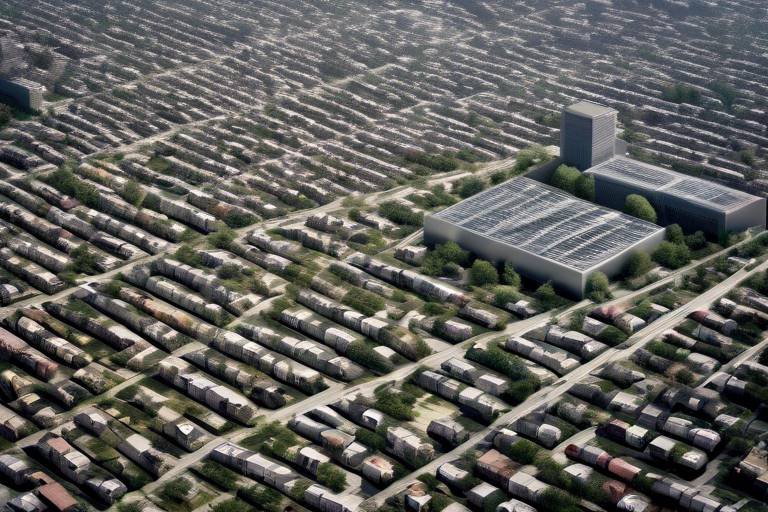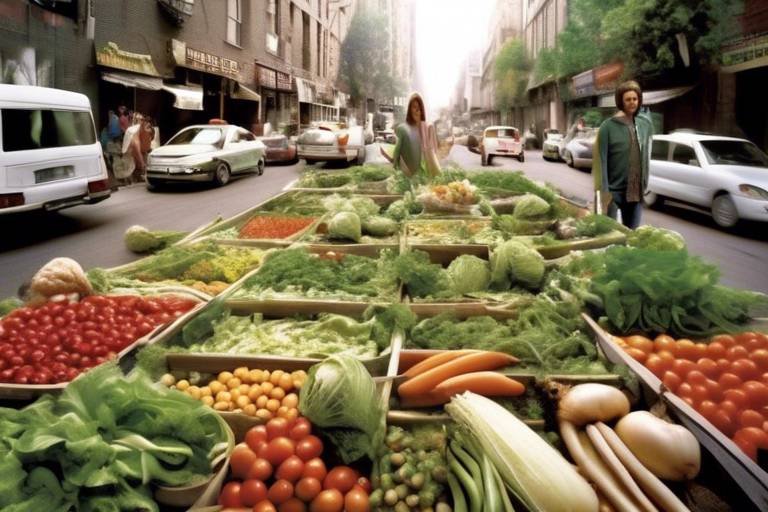Make Your Commute Greener: Transportation Tips for Urban Areas
In today's fast-paced world, urban commuting can often feel like a necessary evil. However, it doesn't have to be! By adopting a few simple strategies, you can significantly reduce your carbon footprint while navigating the bustling streets of your city. This article explores effective methods to embrace sustainable transportation options, highlighting the benefits and practical tips for a greener lifestyle. Imagine transforming your daily commute into an eco-friendly journey that not only benefits the planet but also enhances your overall well-being!
Utilizing public transit systems can significantly lower individual carbon emissions. Think about it: every time you hop on a bus or train, you're leaving your personal vehicle behind, which means fewer cars on the road and cleaner air for everyone. Public transportation is often more efficient than driving alone, especially during peak hours when traffic congestion can turn a quick drive into a frustrating ordeal. Plus, many cities are investing in their public transit infrastructure, making it more reliable and user-friendly than ever before.
To maximize efficiency and convenience when using these services, consider the following tips:
- Plan Ahead: Use transit apps to check schedules and plan your route before you leave.
- Off-Peak Travel: If your schedule allows, try to travel during off-peak hours to avoid the rush.
- Stay Informed: Sign up for alerts regarding service changes or delays to stay on top of your commute.
Carpooling is not just a practical solution; it's a fantastic way to foster community connections while reducing the number of vehicles on the road. By sharing rides, you not only cut down on emissions but also save on fuel costs, making it a win-win situation! Imagine sharing a ride with a neighbor or a colleague, turning what could be a mundane commute into an opportunity for conversation and camaraderie.
Discovering carpool partners has never been easier, thanks to technology. Various platforms and apps facilitate carpooling, allowing you to connect with others who share similar routes. Websites like CarpoolWorld or apps such as Waze Carpool make it simple to find someone to share the ride with. Additionally, consider creating or joining local carpool groups through social media platforms or community boards to enhance your sustainable commute.
Beyond the environmental impact, carpooling offers numerous benefits:
- Financial Savings: Share fuel costs and reduce wear and tear on your vehicle.
- Reduced Stress: Enjoy the company of others rather than battling traffic alone.
- Social Interaction: Build relationships with people in your community.
While carpooling is a great option, safety is paramount. Always establish trust among participants by conducting background checks if necessary. Consider setting up a group chat to communicate easily and ensure everyone feels comfortable. Remember, a safe ride-sharing experience is crucial for fostering long-term carpool relationships.
Multimodal transportation can optimize your commute and make it more enjoyable. By effectively combining walking, biking, and public transit, you can create a seamless and eco-friendly travel experience. For example, consider biking to the nearest subway station, then taking the train to your destination. This not only reduces your carbon footprint but also adds a bit of exercise to your day!
Biking is an excellent way to reduce emissions while improving your health. Imagine feeling the wind on your face as you pedal through the city, all while knowing you're making a positive impact on the environment. Cycling is not only a fun way to get around, but it also offers numerous health benefits, such as improved cardiovascular fitness and reduced stress levels.
Selecting the right bike is crucial for a comfortable ride. Whether you prefer a road bike, a mountain bike, or a hybrid, make sure it suits your commuting needs. Don't forget to invest in accessories like a good helmet, lights, and a sturdy lock to enhance your biking experience.
Safety and maintenance are key to enjoyable biking. Always wear a helmet and follow traffic rules to ensure your safety on the road. Regularly check your bike's brakes, tires, and chain to keep it in top condition. Local resources such as bike shops and community cycling events can offer valuable support and information for cyclists.
Q: How can I start using public transportation in my city?
A: Begin by researching your local transit system. Download transit apps, familiarize yourself with routes, and plan your first trip during a less busy time.
Q: What if I can't find a carpool partner?
A: Consider using carpooling apps or social media groups to connect with others. You can also reach out to coworkers or neighbors who might be interested in sharing rides.
Q: Is biking safe in urban areas?
A: Yes, biking can be safe if you follow traffic laws, wear a helmet, and stay aware of your surroundings. Choose bike lanes whenever possible and maintain your bike regularly.

Embrace Public Transportation
Utilizing public transportation is one of the most effective ways to reduce your carbon footprint while navigating the bustling streets of urban areas. Think about it: every time you hop on a bus, train, or subway, you're not just easing your own commute; you're also contributing to a larger movement towards sustainability. Public transit systems are designed to accommodate many passengers at once, which means fewer individual cars on the road. This not only cuts down on greenhouse gas emissions but also helps alleviate traffic congestion, making your city a more pleasant place to live and work.
One of the biggest advantages of public transportation is its affordability. In many cities, the cost of a monthly transit pass is significantly lower than the combined expenses of gas, parking, and maintenance for a personal vehicle. Plus, with rising fuel prices, public transit can save you a considerable amount of money. Imagine being able to put that extra cash towards something fun, like a weekend getaway or a new hobby!
But let’s not forget about the convenience factor. Many urban areas have extensive public transit networks that connect you to key locations like work, schools, and entertainment hubs. To maximize your experience, consider the following tips:
- Plan Ahead: Use apps or websites to check schedules and map out your route before you leave home.
- Be Flexible: Sometimes, taking a different route or mode of transport can save you time and make your journey more enjoyable.
- Stay Informed: Keep an eye on service alerts and updates, especially during peak travel times or inclement weather.
Moreover, public transportation can also be a great way to meet new people and engage with your community. Whether it's striking up a conversation with a fellow commuter or discovering local events advertised on transit posters, you never know what opportunities might arise. Additionally, many cities are investing in green technology for their public transit systems, such as electric buses and energy-efficient trains, further enhancing the environmental benefits of using these services.
In summary, embracing public transportation is not just a practical choice; it's a lifestyle shift that can lead to a greener, more connected urban experience. By choosing to ride the bus or train, you’re not only making a smart financial decision but also playing a vital role in reducing emissions and fostering a sense of community. So next time you're thinking about how to get to your destination, consider leaving your car at home and hopping on the next bus or train instead!

Consider Carpooling
Carpooling is like finding a hidden gem in the world of commuting. Not only does it help reduce the number of cars on the road, but it also creates a sense of community among those who share rides. Imagine cruising down the highway, not just with a driver, but with a friend or two, sharing stories, laughter, and perhaps even snacks! The benefits of carpooling go beyond just saving money on gas; it’s an opportunity to connect with others, reduce stress, and contribute positively to the environment.
When you carpool, you’re not only cutting down on your carbon footprint, but you’re also saving on wear and tear on your vehicle, which can translate to significant cost savings in the long run. Think about it: fewer trips to the gas station, reduced maintenance costs, and even less time spent in traffic. It’s a win-win situation! But how do you find the right carpool partners? That’s where technology comes to the rescue.
Thanks to modern technology, finding carpool partners has never been easier. There are numerous platforms and apps designed specifically for this purpose. Whether it’s a local Facebook group, a dedicated carpooling app, or even community boards, the options are plentiful. Here are some popular platforms:
- Waze Carpool - This app connects drivers and riders heading in the same direction.
- Carpool World - A global platform for finding carpool partners.
- Blablacar - Ideal for longer distances, connecting travelers with similar routes.
When creating or joining a local carpool group, consider factors like your work schedule, pickup and drop-off locations, and the number of people you’re comfortable sharing a ride with. Communication is key, so make sure everyone is on the same page regarding expectations and routines.
The benefits of carpooling extend far beyond just financial savings. Think of it as a little eco-friendly revolution right in your neighborhood! Here’s a closer look at what you gain:
- Environmental Impact: Fewer cars on the road mean reduced emissions and less traffic congestion.
- Cost-Effectiveness: Sharing fuel costs can lead to substantial savings.
- Social Connections: Carpooling can foster friendships and a sense of community.
By sharing rides, you’re not just helping yourself; you’re contributing to a larger movement towards sustainability. Plus, you might just make a new friend along the way!
While carpooling has numerous benefits, safety should always be a top priority. Establishing trust among participants is crucial. Here are some best practices to ensure a secure ride-sharing experience:
- Background Checks: If possible, conduct background checks on potential carpool partners to ensure everyone feels safe.
- Set Ground Rules: Discuss and agree on rules regarding pick-up times, drop-off locations, and any other expectations.
- Communication: Keep open lines of communication through messaging apps or group chats.
By following these guidelines, you can enjoy the benefits of carpooling while ensuring a safe and pleasant experience for everyone involved.

Finding Carpool Groups
In today's fast-paced urban environment, finding reliable carpool groups can feel like searching for a needle in a haystack. Luckily, with the right tools and strategies, you can connect with fellow commuters who share your passion for reducing emissions and saving money. One of the best ways to start your journey is by leveraging technology. There are numerous platforms and apps designed specifically for carpooling, making it easier than ever to find a ride-sharing partner. For instance, apps like Carpool World, Waze Carpool, and Blablacar are popular choices that allow users to match with others traveling in the same direction.
When using these platforms, it's essential to set clear expectations. Make sure to communicate your schedule, preferred pick-up points, and any other relevant details. This not only helps in finding the right match but also establishes a sense of trust among participants. Additionally, consider joining local community groups on social media platforms like Facebook or Reddit. These groups often have dedicated threads for carpooling, where you can post your needs or browse through others' offers.
Another effective way to find carpool partners is through your workplace or educational institution. Many companies and schools have internal programs or bulletin boards dedicated to ride-sharing. By taking advantage of these resources, you can connect with colleagues or classmates who live nearby and are interested in carpooling. This not only makes your commute more sustainable but also fosters a sense of community.
Lastly, don’t underestimate the power of word-of-mouth. Talk to friends, family, or neighbors about your interest in carpooling; you might be surprised to discover that someone in your circle is also looking for a carpool buddy. Building a carpool group can be as simple as gathering a few like-minded individuals who are willing to share the ride.
In summary, finding a carpool group is all about utilizing the right resources and being proactive in your search. Whether through apps, community groups, workplace initiatives, or simply asking around, there are plenty of opportunities to connect with others who share your goal of greener commuting.

Benefits of Carpooling
Carpooling is not just a trendy buzzword; it’s a fantastic way to make your daily commute more sustainable and enjoyable. Imagine reducing your carbon footprint while simultaneously saving money and making new friends! The benefits of carpooling are multifaceted, and they can transform the way you think about your daily travels. Here are some of the key advantages:
- Environmental Impact: By sharing a ride, you help decrease the number of vehicles on the road. This reduction leads to lower greenhouse gas emissions, contributing to a healthier planet. Think of it as planting a tree every time you share a ride!
- Cost Savings: Carpooling can significantly cut down on fuel expenses. With the rising costs of gas, splitting the bill with others can be a game-changer for your wallet. Plus, there are often toll and parking savings when you carpool.
- Time Efficiency: Many cities offer carpool lanes that allow vehicles with multiple passengers to bypass traffic. This can lead to shorter travel times, making your commute not only greener but also faster!
- Social Connections: Carpooling is a great way to meet new people and strengthen community ties. Whether it’s bonding over shared interests or simply chatting about your day, the social aspect can make commuting a lot more fun.
Moreover, carpooling can alleviate the stress of driving alone. Picture this: instead of navigating through rush hour solo, you’re sharing the experience with others. You can catch up on your favorite podcast, read a book, or simply relax while someone else takes the wheel. It’s like having a little slice of camaraderie in your otherwise busy day.
Additionally, many employers are recognizing the benefits of carpooling and are incentivizing it. Some companies offer preferred parking spots for carpoolers or even financial incentives to encourage employees to share rides. This not only boosts morale but also promotes a culture of sustainability within the workplace.
In conclusion, the benefits of carpooling extend far beyond just saving money or reducing emissions. It’s about creating a community, fostering connections, and making a positive impact on the environment. So, why not give it a try? You might be surprised at how much you enjoy the ride!
Q: How do I find carpool partners?
A: There are many apps and websites designed to connect potential carpoolers. Additionally, consider reaching out to coworkers or friends who live nearby.
Q: Is carpooling safe?
A: Yes, carpooling can be safe if you take the necessary precautions. Always meet in public places, discuss safety protocols, and consider background checks.
Q: What if my carpool partner is late?
A: It’s important to set clear expectations with your carpool group. Discuss what to do in case of delays before you start carpooling.
Q: Can I carpool if I don't have a car?
A: Absolutely! You can still participate in carpooling by joining a group that has a driver, or by using public transportation to meet your carpool group.

Safety Considerations
When it comes to carpooling, safety should always be your top priority. After all, you're sharing a ride with strangers, and ensuring a secure environment is essential for a positive experience. First and foremost, it's crucial to establish a sense of trust among participants. This can be achieved by conducting background checks on potential carpool partners. Many carpooling apps offer built-in verification systems to help you feel more secure about who you’re riding with.
Additionally, consider setting some ground rules before hitting the road. Discuss topics such as music preferences, air conditioning settings, and even snack policies to ensure everyone is on the same page. Open communication is key, and it can help prevent misunderstandings that could lead to discomfort during your commute.
Another vital aspect of safety is vehicle condition. Make sure that the car you’re riding in is well-maintained and equipped with necessary safety features. Regular checks on the brakes, tires, and lights can greatly reduce the risk of accidents. It's also a good idea to ensure that all passengers wear their seatbelts at all times, as this simple action can significantly enhance safety on the road.
Here are some additional best practices to consider for a secure ride-sharing experience:
- Use Trusted Platforms: Opt for reputable carpooling apps that prioritize user safety and provide features like driver ratings and reviews.
- Share Your Itinerary: Let a friend or family member know your carpooling plans, including who you’re riding with and where you’re going.
- Stay Alert: Keep an eye on your surroundings and trust your instincts. If something feels off, don’t hesitate to exit the situation.
By taking these precautions, you can enjoy the benefits of carpooling while minimizing risks. Remember, a safe commute not only protects you but also contributes to a more positive carpooling culture in your community. So buckle up and enjoy the ride!
Q1: How can I find trustworthy carpool partners?
A1: Use reputable carpooling apps that have user reviews and verification processes to help you find reliable partners.
Q2: What should I do if I feel unsafe during a carpool ride?
A2: Trust your instincts. If you feel uncomfortable, you can ask the driver to drop you off at a safe location or exit the vehicle if necessary.
Q3: Are there any specific safety features I should look for in a vehicle?
A3: Ensure the vehicle has functioning seatbelts, airbags, and good brakes. Regular maintenance checks are also essential for safety.
Q4: Can I set rules for the carpool?
A4: Absolutely! Discussing and agreeing on ground rules beforehand can help ensure a comfortable and enjoyable experience for everyone.

Combining Modes of Transport
In today's bustling urban environments, the idea of using just one mode of transport might feel a bit outdated. Imagine your daily commute as a symphony, where each instrument plays a vital role in creating a harmonious experience. By combining different modes of transport, you can not only optimize your travel time but also contribute to a greener planet. This approach allows you to leverage the strengths of each transportation method, whether it's walking, biking, or hopping on public transit.
For instance, consider starting your day with a refreshing bike ride to the nearest subway station. This not only gets your blood pumping but also reduces the stress of navigating through traffic. Once you reach the station, you can easily hop on a train, skipping the congestion that often comes with driving alone. This seamless transition between biking and public transport can drastically cut down your carbon emissions while making your commute more enjoyable.
One of the key advantages of combining modes of transport is the flexibility it offers. You can tailor your route based on real-time traffic conditions or weather changes. For example, if it’s a rainy day, you might choose to take the bus instead of biking. On sunny days, a bike ride to the train station might be just what you need. This adaptability not only keeps your commute interesting but also helps you stay active and engaged with your surroundings.
To get the most out of your multimodal commuting experience, consider the following tips:
- Plan Your Route: Use apps and maps that show bike lanes, bus stops, and train stations to create an efficient route.
- Invest in a Good Bike Lock: Ensure your bike is secure while you’re using public transport.
- Stay Informed: Check for any service disruptions or delays in public transport to avoid unnecessary waiting times.
As you explore the city, you'll find that combining these modes of transport can lead to unexpected adventures. Perhaps you'll discover a hidden park while biking, or meet new friends on the train. Each journey becomes an opportunity to connect with your community and the environment around you.
Moreover, there’s a significant environmental benefit to this approach. By reducing reliance on single-occupancy vehicles, you’re not just cutting down on greenhouse gas emissions; you're also helping to alleviate traffic congestion and improve air quality. It’s a win-win situation, where you can enjoy the perks of urban life while being a responsible citizen.
In conclusion, combining modes of transport is not merely a practical solution; it’s a lifestyle choice that promotes sustainability and community engagement. So, the next time you're planning your commute, think about how you can mix things up. Whether it’s biking to the bus stop or walking to the train station, each small step contributes to a larger impact. Embrace the journey, and let your commute reflect your commitment to a greener future!
Q1: What are the benefits of combining different modes of transport?
A1: Combining different modes of transport can save time, reduce carbon emissions, and enhance your overall commuting experience by offering flexibility and variety.
Q2: How can I find the best routes for multimodal commuting?
A2: Use navigation apps that provide real-time information about bike lanes, public transport schedules, and traffic conditions to plan your routes effectively.
Q3: Is it safe to bike to public transport stations?
A3: Yes, biking to public transport stations is generally safe, especially if you follow traffic rules, wear a helmet, and use designated bike lanes. Always secure your bike with a good lock.

Opt for Biking
Biking is not just a mode of transportation; it’s a lifestyle choice that can significantly reduce your carbon footprint while keeping you fit and energized. Imagine gliding through the city, the wind in your hair, and the vibrant sights and sounds of urban life surrounding you. It’s an exhilarating experience that not only benefits the environment but also your health. With the rise of urban congestion and pollution, opting for biking is like choosing a refreshing breeze over a stuffy room. So, why not hop on two wheels and make your commute greener?
One of the most appealing aspects of biking is its environmental impact. According to studies, a single bike can replace a car for short trips, which are often the most polluting. By choosing to bike instead of drive, you’re not only cutting down on greenhouse gas emissions but also reducing noise pollution and traffic congestion. Plus, it’s a fantastic way to explore your city, discover hidden gems, and enjoy the outdoors. Have you ever noticed how much more you see when you’re not stuck in traffic?
When it comes to biking, safety is paramount. Before you hit the road, it’s essential to equip yourself with the right safety gear. This includes a well-fitted helmet, reflective clothing, and lights for those evening rides. Ensuring your bike is in top shape is equally important. Regular maintenance checks can prevent accidents and ensure a smooth ride. To make this easier, consider creating a simple maintenance schedule:
| Maintenance Task | Frequency |
|---|---|
| Check tire pressure | Weekly |
| Inspect brakes | Monthly |
| Lubricate chain | Every 100 miles |
| Clean bike | Monthly |
Now, let’s talk about the type of bike that suits your commuting needs. The market is filled with various options, from road bikes to hybrid models, and each serves a different purpose. If you’re commuting on smooth city roads, a road bike might be your best bet for speed and efficiency. On the other hand, if you plan to navigate through parks or uneven terrain, a mountain bike or a hybrid could offer the versatility you need. When selecting a bike, consider factors such as:
- Comfort: Ensure the bike fits you well to avoid discomfort during longer rides.
- Storage: Look for bikes that allow you to carry essentials, like a backpack or a basket.
- Durability: Invest in a sturdy bike that can withstand daily use.
Another significant advantage of biking is that it promotes a healthier lifestyle. It’s a fantastic way to incorporate exercise into your daily routine without having to hit the gym. Riding your bike can burn calories, improve cardiovascular health, and boost your mood. Plus, it’s a great stress reliever! Just think about it: pedaling your way through the city can be a form of meditation, allowing you to clear your mind and focus on the present.
Lastly, let’s not forget the community aspect of biking. Many cities have vibrant cycling communities that host events, group rides, and workshops. Joining these groups can not only enhance your biking experience but also introduce you to like-minded individuals who share your passion for sustainable commuting. It’s a win-win situation; you get to enjoy the ride while building connections with fellow cyclists.
Q: Is biking safe in urban areas?
A: Yes, biking can be safe in urban areas if you follow traffic rules, wear safety gear, and stay alert. Many cities are improving bike lanes and infrastructure to make cycling safer.
Q: What should I do if I don’t own a bike?
A: Many cities offer bike-sharing programs, allowing you to rent bikes for short periods. This is a great way to start biking without the commitment of purchasing a bike.
Q: How do I stay motivated to bike regularly?
A: Set personal goals, join local biking groups, and explore new routes to keep your biking experience fresh and exciting.

Choosing the Right Bike
When it comes to commuting, selecting the right bike can make all the difference between a smooth ride and a bumpy experience. With so many options available, it’s essential to consider your personal needs and the type of commute you’ll be undertaking. Are you looking for speed, comfort, or perhaps a bike that can handle a variety of terrains? Each factor plays a crucial role in your decision-making process.
First off, let’s talk about the different types of bikes available. If you’re navigating through city streets, a commuter bike might be your best bet. These bikes are designed for comfort and practicality, often featuring racks for carrying groceries or a laptop bag. On the other hand, if you’re looking for something more versatile, a hybrid bike can offer a blend of road and mountain bike features, making it perfect for both paved paths and light trails.
For those who crave speed, a road bike with its lightweight frame and thin tires can help you zip through traffic in no time. However, keep in mind that road bikes are less comfortable for longer rides due to their aggressive riding position. If you prefer a more relaxed posture, a cruiser bike might be the way to go. These bikes are perfect for leisurely rides and are often equipped with wider tires and comfortable seats, making them ideal for short trips around the neighborhood.
Another critical aspect to consider is the size of the bike. A properly fitted bike can enhance your comfort and efficiency while riding. Most bike shops offer fitting services, which can help you find the perfect frame size and make adjustments to the seat and handlebars. Remember, riding a bike that’s too big or too small can lead to discomfort and even injury over time.
Let’s not forget about accessories! Investing in a few essential items can significantly improve your biking experience. A good quality helmet is a must for safety, while lights and reflectors will help you stay visible during early morning or late evening rides. Additionally, consider adding a bike lock to protect your investment, especially if you plan to park it in public areas.
In summary, choosing the right bike involves a mix of understanding your commuting needs, evaluating the types of bikes available, and ensuring you have the proper fit and accessories. Whether you opt for a sleek road bike or a sturdy hybrid, the key is to find something that feels right for you. After all, the goal is to make your commute not only greener but also enjoyable!
1. What is the best type of bike for commuting?
The best type of bike depends on your commuting environment. For city riding, a commuter or hybrid bike is often ideal. For longer distances on paved roads, a road bike may be more suitable.
2. How do I know what size bike I need?
Bike size is determined by your height and inseam. Most bike shops provide fitting services to help you find the right size for your comfort and efficiency.
3. Are there any essential accessories I should buy?
Yes! A good helmet, lights for visibility, a reliable lock, and perhaps a comfortable seat cover are all great investments for a safer and more enjoyable ride.
4. How can I maintain my bike for optimal performance?
Regular maintenance includes checking tire pressure, lubricating the chain, and ensuring brakes are functioning properly. It's also beneficial to take your bike to a professional for tune-ups periodically.

Bike Safety and Maintenance
When it comes to biking, safety and maintenance are not just optional; they're essential for a smooth and enjoyable ride. Imagine cruising down the street, the wind in your hair, feeling free and energized. But hold on! Before you embark on your cycling adventure, you need to ensure that both you and your bike are ready for the journey ahead. This means investing time in safety gear and regular maintenance to keep your bike in top shape.
First things first, let’s talk about safety gear. Wearing a helmet is non-negotiable; it’s your first line of defense against potential accidents. Additionally, consider wearing bright clothing and using reflective gear, especially if you’re riding at dawn or dusk. Visibility is key! You might think, “I can just ride carefully,” but remember, it’s not just about your actions; it’s about being seen by others on the road.
Now, let’s dive into maintenance. Regularly checking your bike can save you from unexpected breakdowns. Here are some crucial components to keep an eye on:
- Tires: Ensure they are properly inflated and free from punctures. A flat tire can turn a pleasant ride into a frustrating ordeal.
- Brakes: Test your brakes before every ride. They should respond quickly and effectively to ensure your safety.
- Chain: Keep your chain clean and lubricated. A well-maintained chain not only enhances performance but also extends the life of your bike.
Additionally, consider scheduling a professional tune-up at least once a year. This can help catch any issues that you might overlook during your routine checks. You wouldn’t drive a car without regular maintenance, so why treat your bike any differently?
For those who are new to biking or want to improve their skills, many local bike shops offer workshops on bike maintenance. These sessions can be invaluable, teaching you how to handle basic repairs and adjustments. Plus, you’ll meet fellow biking enthusiasts who can share tips and tricks!
In summary, prioritizing bike safety and maintenance is crucial for a successful commuting experience. By investing in the right gear and keeping your bike in excellent condition, you’ll not only enhance your own safety but also contribute to a greener, healthier urban environment. So, gear up, stay safe, and enjoy the ride!
Q1: How often should I check my bike before riding?
A: It's best to perform a quick safety check before every ride. Look at your tires, brakes, and chain to ensure everything is functioning properly.
Q2: What should I do if I get a flat tire while riding?
A: If you have a flat tire, find a safe spot to pull over. If you have a spare tube and the necessary tools, you can replace it. Otherwise, consider calling for assistance.
Q3: Is wearing a helmet really necessary?
A: Absolutely! A helmet significantly reduces the risk of head injuries in case of an accident. Always wear one, regardless of how short your ride is.
Q4: How can I keep my bike chain clean?
A: Use a degreaser and a brush to clean the chain, then apply bike-specific lubricant to keep it running smoothly. Regular cleaning will prolong the life of your chain.
Frequently Asked Questions
- What are the benefits of using public transportation?
Public transportation is a fantastic way to reduce your carbon footprint. It not only cuts down on individual vehicle emissions but also helps alleviate traffic congestion. Plus, it can be a lot cheaper than owning and maintaining a car!
- How can I find carpool partners?
Finding carpool partners is easier than ever with various apps and platforms available. Websites like Carpool World or apps like Waze Carpool can connect you with others looking to share rides. You can also check local community boards or social media groups.
- Is carpooling safe?
Safety is crucial when it comes to carpooling. Always consider doing background checks on potential carpool partners and establish clear communication about expectations. Trust is key, so take the time to get to know your fellow riders.
- What is multimodal transportation?
Multimodal transportation is all about combining different modes of travel, like biking, walking, and public transit, to create a more efficient commute. It’s a great way to enjoy the benefits of each mode while minimizing your environmental impact.
- What type of bike should I choose for commuting?
Choosing the right bike depends on your commuting needs. If you’re traveling short distances on city streets, a hybrid or commuter bike might be best. For longer distances or rough terrains, consider a road bike or mountain bike. Don’t forget essential accessories like a helmet and lights!
- How can I ensure my bike is safe and well-maintained?
Regular maintenance is key to safe biking. Make sure to check your tires, brakes, and chain frequently. Invest in quality safety gear like a helmet and reflective clothing. Local bike shops often offer maintenance classes that can help you keep your bike in top shape.



















